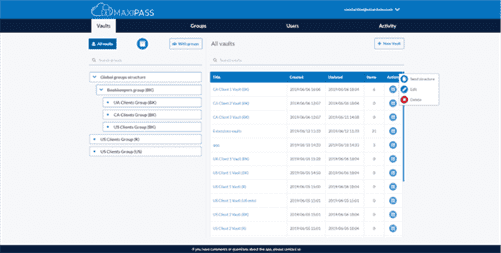LayerZero is a cross-chain communication protocol that enables direct, trustless communication between blockchains. LayerZero supports multiple blockchains, including SUI, Aptos, EVM Chains, and Solana. Projects can implement interoperability to other blockchains with LayerZero. Wonderfully enough, governments https://www.globalcloudteam.com/ are looking beyond just cryptocurrency when it comes to deploying this technology – to record land ownership, for example. So it’s a big problem really – modern life requires that we rely on, trust in and pay for “trusted” third party intermediaries to ensure that value does actually digitally “change hands”.
- Bitcoin was the first cryptocurrency to be created and is the most well-known.
- To assure the integrity of a block and the data contained in it, the block is usually digitally signed.
- Blockchain supports smart contracts, which are programs that trigger transactions automatically upon fulfillment of contract criteria.
- The potential for blockchain applications are endless, from supply chain tracking to workflow automation.
- The private and public keys work together to unlock the data in the ledger.
- The appeal of cryptocurrencies is that everything is recorded in a public ledger and secured using cryptography, making an irrefutable, timestamped and secure record of every payment.
Banks and financial institutions across the globe continue to be leaders in blockchain adoption. Manufacturing and similar businesses also see potential to use blockchain to manage smart contracts and track materials as they move through supply chains . And finally, a blockchain is a database that is shared across a public or private network. One of the most well-known public blockchain networks is the Bitcoin blockchain. These are more applicable to banking and fintech, where people need to know exactly who is participating, who has access to data, and who has a private key to the database.
Software Risk Analysis
And in the case of a property dispute, all the claims of the property need to be reconciled with the public index. Blockchains are transparent, so users can easily check and view every single action in the ledger. Moreover, every participant is given a unique alphanumeric identification number that displays their transactions. Blockchain can be used to create secure and tamper-proof digital identities that can be used to verify personal information and other sensitive data. This could become increasingly important as more of our personal information and assets move online. Miners must use powerful computers to solve mathematical problems to mine new coins and secure the network.

The consensus mechanism is what allows the network of computers to agree on the state of the ledger. Blockchain is a distributed database that maintains a continuously growing list of records called blocks. Blockchain is often said to have the potential to disrupt many what are blockchain solutions industries, including banking, law, and healthcare. The block contains a digital signature, a timestamp, and other important, relevant information. It should be noted that the block doesn’t include the identities of the individuals involved in the transaction.
Blockchain – trends, adoption, and future
With the Ethereum platform, users can also create programmable tokens and smart contracts which are built directly upon the Ethereum blockchain infrastructure. Blockchain as a Service is a cloud-based offering that allows customers to build, host, and use their blockchain applications, smart contracts, and functions on the Azure cloud platform. Azure offers integrated services that make it easy to develop, deploy, and manage blockchain applications. Customers can use Azure’s managed services to create and deploy blockchain applications without having to set up and manage their infrastructure. Ripple uses a decentralized network of computers to keep track of all transactions made using the currency. Ripple uses a proof-of-work algorithm to validate transactions and add them to the blockchain.

If you have an international staff, you know that overseas payroll payments are expensive and inefficient. International bank transfers can take a long time to process, incur heavy bank charges, and experience currency exchange volatility, all of which cause a headache for both the employer and employee. Blockchain has the potential to streamline processes across many different industries. Proof of stake is an alternative algorithm for securing the Blockchain, which does not require mining.
Financial Services
With blockchain cloud services, transactional data from multiple sources can be easily collected, integrated, and shared. Data is broken up into shared blocks that are chained together with unique identifiers in the form of cryptographic hashes. In September 2015, the first peer-reviewed academic journal dedicated to cryptocurrency and blockchain technology research, Ledger, was announced.
A system that appears vast and complex can be made more transparent through clear steps with explicit terminology explanations. Hyperledger is a global collaboration hosted by The Linux Foundation, including finance, banking, IoT, supply chain, manufacturing, and technology leaders. By creating a cross-industry open standard for distributed ledgers, Hyperledger Fabric allows developers to develop blockchain applications to meet specific needs. Blockchain and cryptography involves the use of public and private keys, and reportedly, there have been problems with private keys. If a user loses their private key, they face numerous challenges, making this one disadvantage of blockchains.
What is the difference between a database and a blockchain?
Perhaps no industry stands to benefit from integrating blockchain into its business operations more than banking. Financial institutions only operate during business hours, usually five days a week. That means if you try to deposit a check on Friday at 6 p.m., you will likely have to wait until Monday morning to see that money hit your account. Each candidate would then be given a specific wallet address, and the voters would send their token or crypto to the address of whichever candidate for whom they wish to vote. The transparent and traceable nature of blockchain would eliminate the need for human vote counting and the ability of bad actors to tamper with physical ballots.

Public blockchains are permissionless and allow everyone to join them. All members of the blockchain have equal rights to read, edit, and validate the blockchain. People primarily use public blockchains to exchange and mine cryptocurrencies like Bitcoin, Ethereum, and Litecoin.
Blockchain and Hyperledger
For example, if Jack tries to carry out a transaction in the future, the rest of the nodes can check Jack’s past transaction records to check whether Jack has enough balance to carry out the current transaction. A typical banking system is characterized by central banks that have some oversight over commercial banks. Private blockchains don’t defer to a central authority and therefore the system is decentralized.
The use of a blockchain removes the characteristic of infinite reproducibility from a digital asset. It confirms that each unit of value was transferred only once, solving the long-standing problem of double-spending. A blockchain can maintain title rights because, when properly set up to detail the exchange agreement, it provides a record that compels offer and acceptance.
Learn the basics of blockchain hands-on
This technology establishes trust and harmony in direct communication between two parties without the involvement of a third party. Ripple is an interesting case study on how fintech providers are using blockchain to modernize the provision of financial services. Rather than compete against traditional banks, Ripple is reaching out to them – offering its digital currency payment rails as a high-speed, more efficient alternative to legacy systems such as SWIFT. Business-to-business transactions can take a lot of time and create operational bottlenecks, especially when compliance and third-party regulatory bodies are involved.
